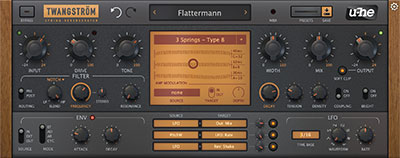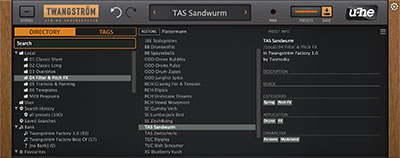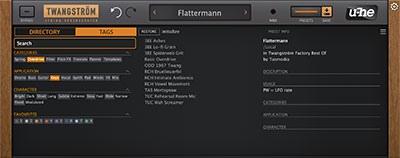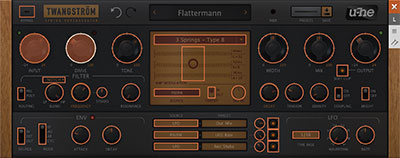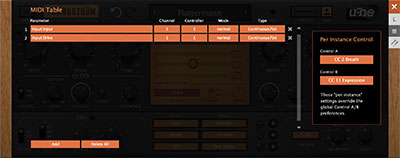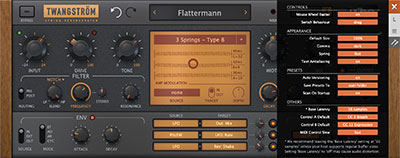

Spring Reverberator
Twangström: Shake, Rattle, and Roll
A flexible spring reverb box-of-tricks. If you’re familiar with Bazille, you might already have come across its built-in spring unit. We took that one, then modelled two more reverb tanks, paired it with drive section, filter stage, envelope, and mod matrix. It emulates a hand-picked selection of the most popular units you will find in classic guitar and instrument amplifiers, recreating the odd character of real springs.
Twangström in the spotlight…
Hover over the dots  to learn about Twangström’s features
to learn about Twangström’s features

- shakeable springs
- 3 different reverberation tanks, inspired by the most popular ones built in the guitar & instrument amps that made rock ’n’ roll
- tasty drive & tone stage for heating-up and colouring the sound
- multi-mode filter, with variable type blend
- four-flavours envelope stage, picking up the signal from either input, output or external sidechain
- LFO module, 8 different types & waveforms, variable time base & syncable
- comprehensive modulation matrix, for realtime control of all the parameters
- independent input and feedback routing options allow all possible stereo or mono combinations
- 76 factory presets, NKS-compatible
- UI instantly resizable from 50% to 200%
- custom remote control via MIDI CC, 14-bit resolution option
Sights and sounds
- Dry/Wet Audio
- Screenshots
Electric Guitar Rhythm DRY
Electric Guitar Rhythm WET
Preset used: Basic 3 SpringsTweaked version of the type-8 tank preset with enabled Bright mode and slightly shorter decay time.
Created by Sascha.
Electric Guitar 1 DRY
Electric Guitar 1 WET
Preset used: Plate #4Simple "vanilla" reverb settings, but LFO and input volume have a subtle effect on the behaviour of the spring, adding some liveliness.
Created by Rob.
Rhodes 1 DRY
Rhodes 1 WET
Preset used: Floating PointSmall amounts of overdrive and subtle high-pass filter movement give the long reverb decay some colour and movement.
Created by Viktor.
Electric Guitar Arpeggio DRY
Electric Guitar Arpeggio WET
Preset used: Basic 2 SpringsAdjusted in Decay & with engaged Bright mode, the result nicely mimics a typical combo-based large-sized reverb tank.
Created by Sascha.
Acoustic Guitar DRY
Acoustic Guitar WET
Preset used: Stanley StuttersApart from the denser reverb tail, this uses a dynamic tremolo on the input signal - louder signal, stronger tremolo.
Created by Rob.
Electric Guitar 2 DRY
Electric Guitar 2 WET
Preset used: Suspension BridgeSmall amounts of overdrive add some grit to the reverb tail, whose wobbly movement comes from the low spring tension setting.
Created by Viktor.
Electric Guitar 3 DRY
Electric Guitar 3 WET
Preset used: Touch of TwangClassic 60s-style guitar, classic 60s-style spring reverb setting.
Created by Rob.
Rhodes 2 DRY
Rhodes 2 WET
Preset used: Wah ScreamerAuto-wah setting where the envelope follower moves the filter to add some funky bite to the electric piano. Very short reverb settings give the impression of a small practise room.
Created by Viktor.
As a faithful emulation of a mechanical device, Twangström needs to be handled well. Many of the technical parameters are user-adjustable in real time, and these can be controlled via MIDI or using the internal LFO and envelope generator. With its multimode resonant filter, Twangström is a unique and powerful tool which can deliver highly unusual, evolving textures … especially when the signal is tossed around using the modulation matrix!
Shakeable springs

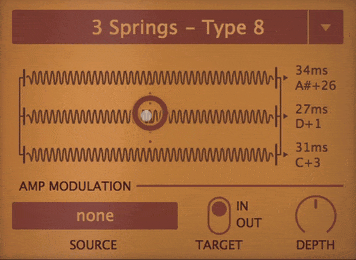
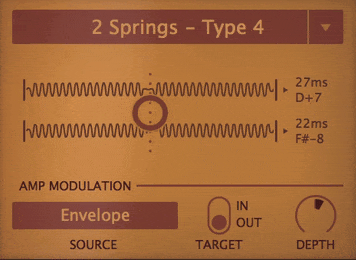
Hitting your computer won’t make Twangström shatter, so we added a twang control. This is used to shake the springs, either manually or through modulation and automation. You might think this is a gimmick for which you have no further use (apart from waking up the neighbours), but if you modulate it slightly, everything comes to life!
Tank controls
Twangström’s reverb is based on physical modelling. As opposed to plug-ins based on impulse responses (IR), our approach mimics the physics of mechanical reverberation. By simulating the wavefront travelling through a medium, we can include all the aspects of excitation, reflection, dispersion, interference, and other audio properties. Twangström does not mimic the sonic result, but simulates the physical device. This means that all dimensions of the device are controllable in realtime, on a per-sample-basis – which all boils down to quite some power at your fingertips!
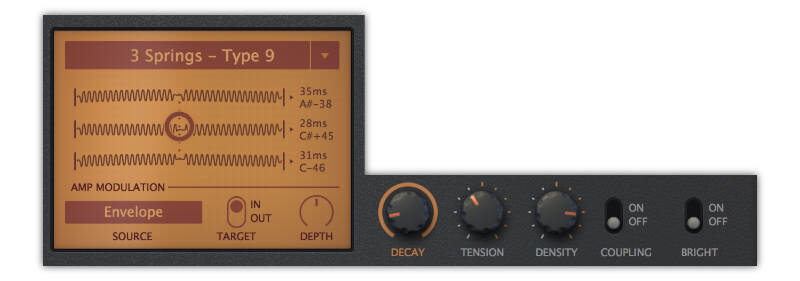
Tank Controls in Twangström’s UI
Envelope
The envelope in Twangström features 4 different modes and can pick up the signal from either input, output or external sidechain. You can select between Envelope Follower, Attack and Decay, Attack and Release, or Cyclic modes. The last one is similar to a 2-stage LFO. Shown controls will adapt to the selected mode, with Threshold not appearing while in Envelope Follower mode.
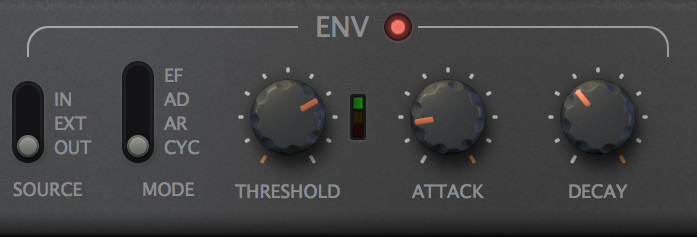
Envelope in Twangström’s UI
Modulation Matrix
The modulation matrix has three general purpose modulation slots, and yes, you can select shake as one of many targets to modulate the Twang control!
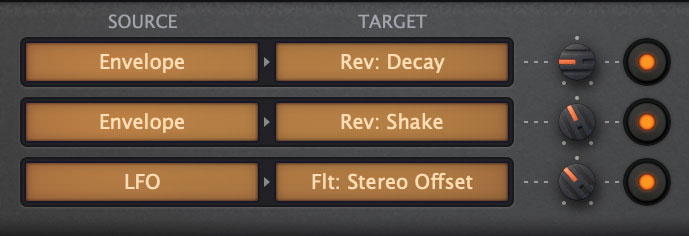
Modulation Matrix in Twangström’s UI
Low Frequency Oscillator
The LFO features different time bases, including a non-synchronized one measured in seconds. Synchronized options include both dotted times and triplets. There are 8 different waveforms to choose from, with 2 of them being stepped or glide random shapes.
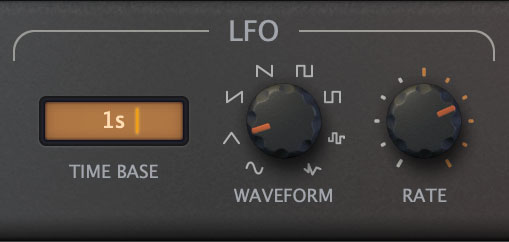
LFO in Twangström’s UI
Shakeable Springs
Modulatable, featuring 3 different reverberation tanks
Multi-Input envelope
In four different flavours
Flexible modulation
- LFO with 8 different waveforms
- variable time base
- syncable
Multi-mode filter
- variable type blend
- pre- or post-tank routing
- stereo offset
Physical Modelling Controls
Drive and Tone stage

Download the demo and enter your serial number to unlock the full version. The demo version emits crackling sound at irregular intervals.
Twangström 1.0.2 (revision 16742)
Released October 15, 2024
Release notes
* About Linux: Before purchasing, please be aware the Linux versions of our plug-ins are still considered beta. While the plug-ins are stable, we are not able to provide the same level of support for these products as we do for the macOS and Windows versions. Support is provided via the Linux and u-he communities on our forum ![]() .
.
Requirements
![]() Mac OS X 10.10 or newer
Mac OS X 10.10 or newer
or
![]() Windows 7 or newer
Windows 7 or newer
or
![]() Linux
Linux
- Host software / DAW
- 1GB RAM, more recommended
- 1000 × 600 or larger display
- 30-90 MB free disk space
- Modern CPU required:
Windows/Linux: Intel Nehalem or newer, AMD Bulldozer or newer
Mac: Intel Nehalem or newer, Apple silicon M1 or newer - Linux: glibc version 2.28 or newer
Formats
Twangström is not a standalone product, it requires host software. Twangström is compatible with nearly all DAWs.
macOS:
CLAP, AUv2, VST3, AAX*
64-bit
Windows:
VST3
32-/64-bit
CLAP, AAX*
64-bit
* AAX requires Pro Tools 10.3.7 or later
![]()
This product is Native Instruments NKS-ready and compatible with Maschine and Komplete Kontrol hardware.
![]()
VST is a trademark of Steinberg Media Technologies GmbH, registered in Europe and other countries.
User Guides
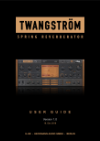
Downloads for Twangström
Try the latest builds of Twangström, which include improvements and bug fixes. Note: these are stable, but still beta versions.
Older Twangström installers are in our release archive (for legacy systems).



